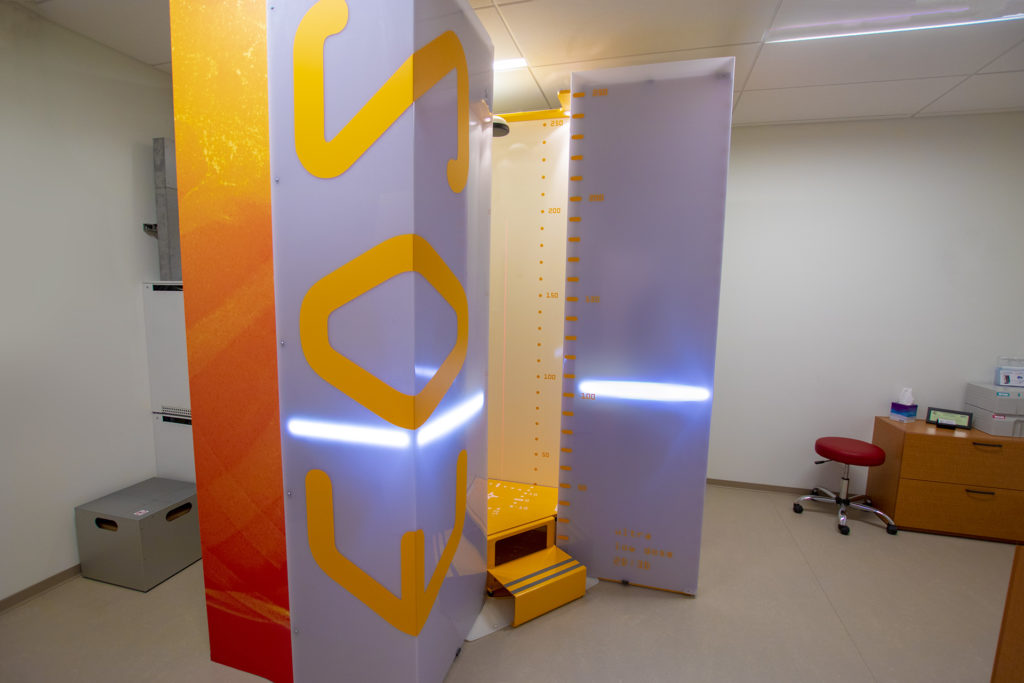The protective leaded apron. The technician’s departure from the room. The awkward moments where you can’t move a muscle. Anyone who has been to a routine dental exam or experienced the misfortune of fracturing a bone would recognize that scenario: an X-ray. An X-ray is a photographic image created using electromagnetic radiation. An X-ray is necessary; however it exposes the patient to radiation, but the result gives the physician access to invaluable data to diagnose and effectively treat the patient. So, when your child is diagnosed with scoliosis and you are told that treatment includes a minimum of three X-rays a year, mostly during the adolescent growth stage, it makes sense that you would have concerns. Luckily, the innovative EOS® imaging system provides an option with significantly lower radiation exposure.
Why So Many X-Rays? Effective diagnosis and treatment of scoliosis require multiple X-rays. Of course, there is the first one used to reach a diagnosis. After that, the patient undergoes X-rays regularly to monitor any curve changes and corrections as part of the observation and treatment process. For the practitioner to accurately ascertain curve changes, X-rays are often required for the full body or a significant portion of the body. Often, multiple traditional X-rays are required at the same appointment to obtain all the necessary views of the spine. The practitioner must then assemble the various views to create a comprehensive picture of the spine and its curve. Any time a patient needs a new brace, more X-rays are also needed. A scoliosis patient typically endures a minimum of three X-ray sessions per year and the treatment period generally lasts for multiple years.
Why EOS®? Fortunately, the EOS® low-dose X-ray provides an option for scoliosis patients, as well as other patients. The EOS® imaging system stems from Nobel Prize-winning scientific research and technology regarding radiation detection. It produces high-quality, extremely detailed images and exposes the patient to far less radiation than a traditional X-ray.
The images produced by the state-of-the-art EOS® imaging system are far superior to anything that a traditional X-ray machine can produce. Just one scan on an EOS® machine produces a complete view of the patient’s skeleton: life-size, naturally weight-bearing, from all angles. In less than 20 seconds, the system creates full frontal and side views of the patient’s skeletal system simultaneously. It eliminates the need for multiple scans at one time; and, the practitioner is no longer required to assemble multiple scans for a proper picture. The images produced by the EOS® imaging system provide the practitioner with the very best possible view of the spine and skeletal system thus allowing the practitioner to make more informed diagnoses and treatment plans. The bottom line for patient health and safety: the patient only requires one very brief scan per session with the EOS® machine thus reducing the patient’s exposure to radiation.
Equally as compelling, the EOS® imaging system exposes patients to far less radiation per scan than a traditional X-ray machine. The system uses low-dose radiation – 50-75 percent less radiation than the traditional X-ray machine. The technology enables the X-ray to focus through a very small slit, thus greatly reducing the radiation exposure for the patient. With a typical scoliosis patient using the EOS® machine, the overall exposure to radiation per imaging exam is equal to only about one week of the earth’s naturally occurring radiation. Again, the patient’s exposure to radiation is significantly reduced compared to traditional X-ray machines and methods.
Scoliosis patients require several X-rays throughout treatment. Understandably, radiation exposure for these patients, often during those important adolescent growth years, is no doubt a concern. Radiation of varying sorts has been used to diagnose medical conditions for decades. Medical professionals and patients alike weigh the risks of radiation exposure from X-rays against the diagnostic benefits. With the option of the EOS® imaging system, that risk is greatly reduced, making the benefits just so much sweeter.
